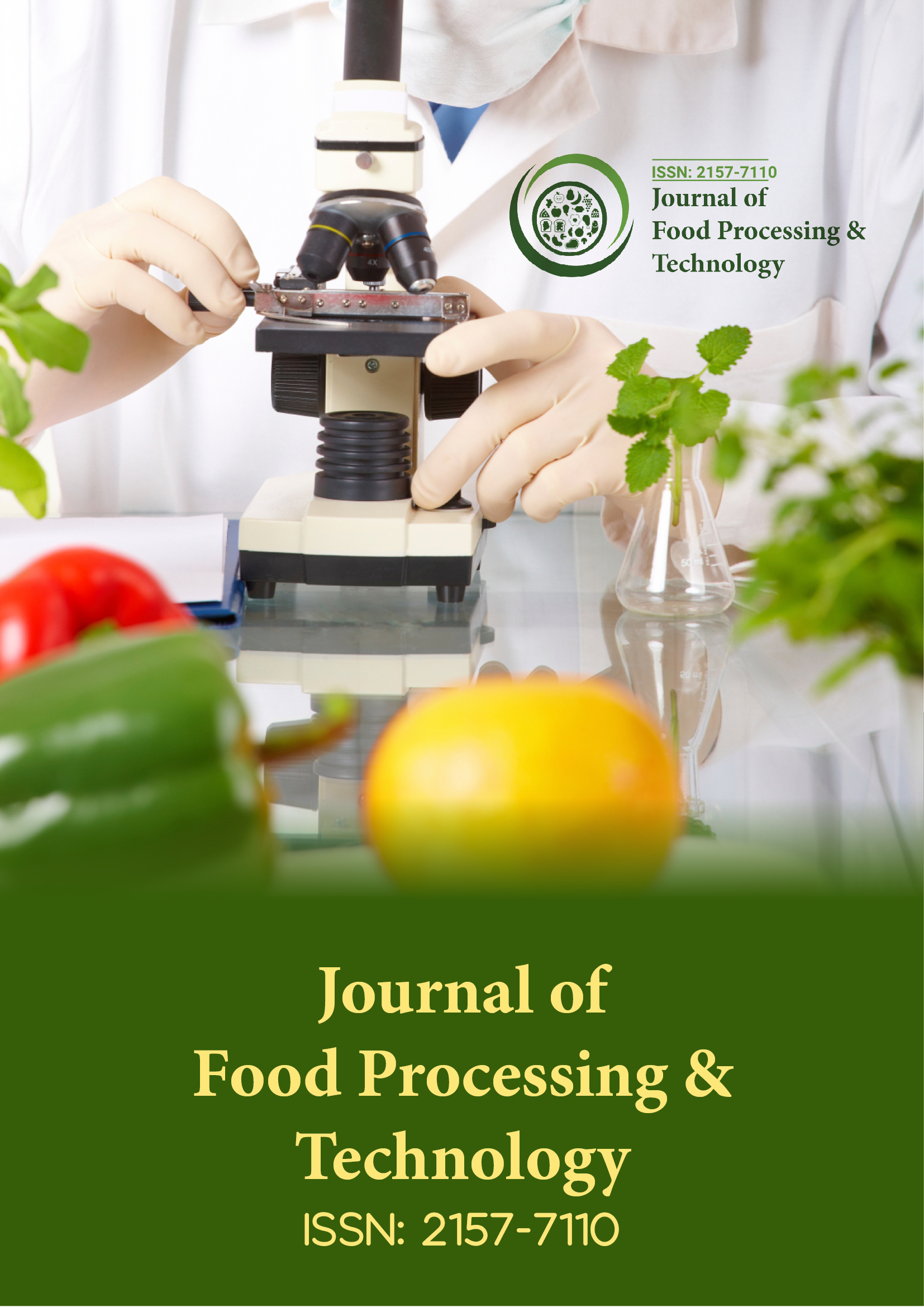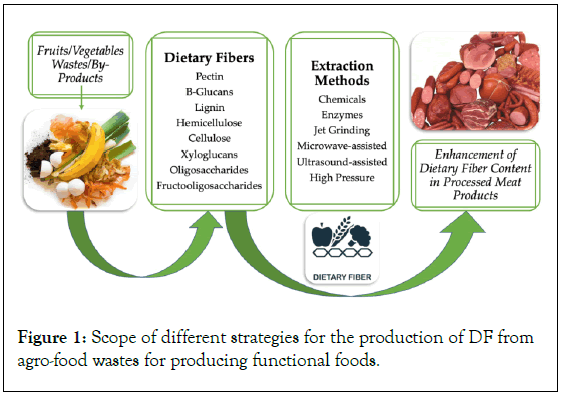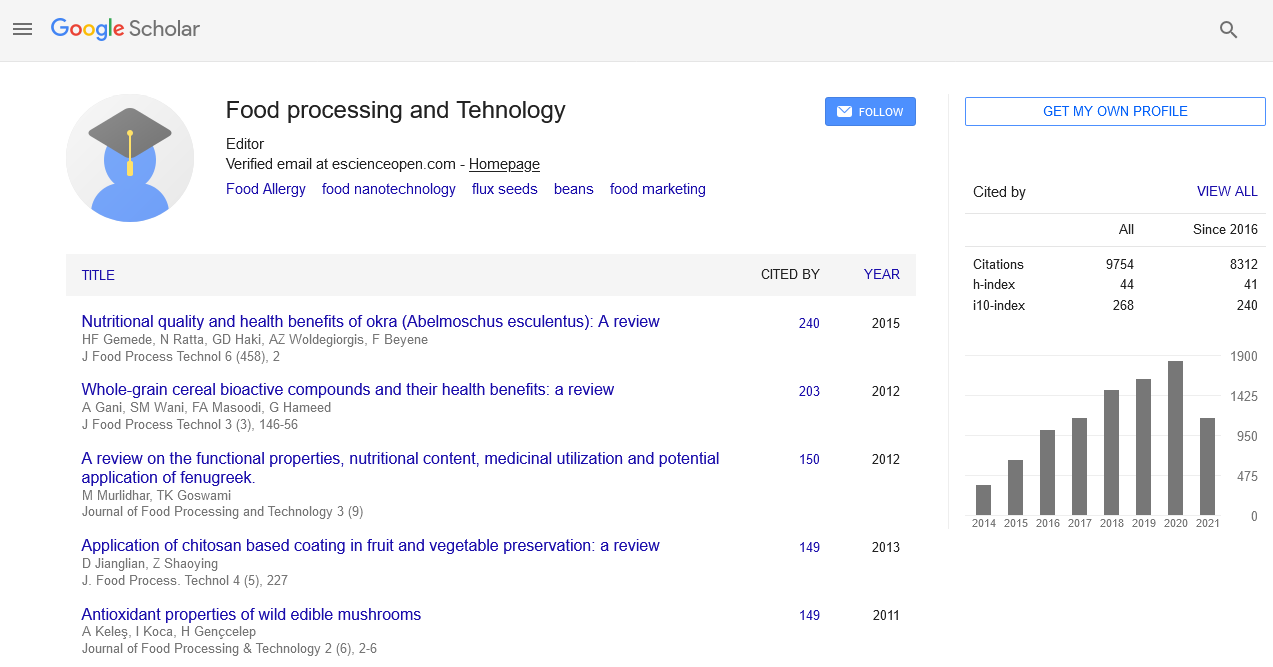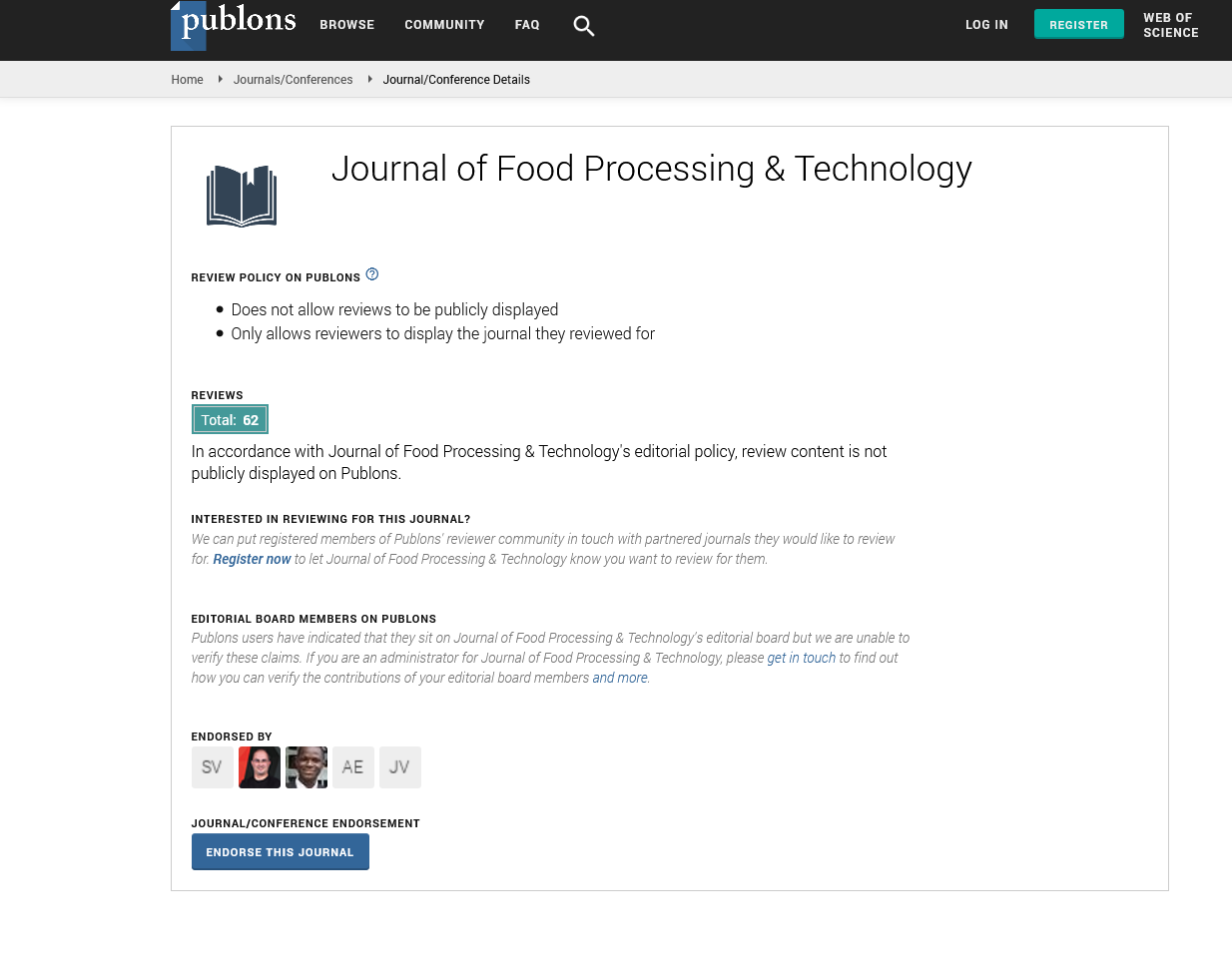Indexed In
- Genamics JournalSeek
- Academic Keys
- JournalTOCs
- China National Knowledge Infrastructure (CNKI)
- Access to Global Online Research in Agriculture (AGORA)
- Centre for Agriculture and Biosciences International (CABI)
- RefSeek
- Directory of Research Journal Indexing (DRJI)
- Hamdard University
- EBSCO A-Z
- OCLC- WorldCat
- Scholarsteer
- SWB online catalog
- Publons
- Euro Pub
- Google Scholar
Useful Links
Share This Page
Journal Flyer

Open Access Journals
- Agri and Aquaculture
- Biochemistry
- Bioinformatics & Systems Biology
- Business & Management
- Chemistry
- Clinical Sciences
- Engineering
- Food & Nutrition
- General Science
- Genetics & Molecular Biology
- Immunology & Microbiology
- Medical Sciences
- Neuroscience & Psychology
- Nursing & Health Care
- Pharmaceutical Sciences
Mini Review - (2023) Volume 14, Issue 11
Recent Advances in Utilization of Novel Dietary Fiber from High Value Agro-Food Wastes
Amirtham Dhamodarasamy1,2*, Logeshwaran Panneerselvan2, Haryni Jayaradhika Raguraman Rengarajan2, Vibin Perumalsamy2, Ayyappan Bharathi3 and Thavamani Palanisami22Department of Environmental and Plastic Innovation Cluster (EPIC), Global Innovative Centre for Advanced Nanomaterials (GICAN), Engineering and Built Environment, the University of Newcastle, Callaghan, Australia
3Department of Plant Breeding and Genetics, Agricultural College and Research Institute (ACRI), Tamil Nadu Agricultural University, India
Received: 13-Oct-2023, Manuscript No. JFPT-23-23578; Editor assigned: 16-Oct-2023, Pre QC No. JFPT-23-23578 (PQ); Reviewed: 31-Oct-2023, QC No. JFPT-23-23578; Revised: 07-Nov-2023, Manuscript No. JFPT-23-23578 (R); Published: 14-Nov-2023, DOI: 10.35248/2157-7110.23.14.1064
Abstract
Dietary Fibers (DF) from wheat, corn and rice had been generally regular in diverse food programs, each for their fitness attributes and technical functionalities. The present-day trend within the food industry is exploration of novel or unusual resources of Dietary Fibers (DF), specifically the by-products from processing of fruits, vegetables, legumes, seeds and sea weeds. Various functional fibers encompass inulin, beta-glucan, psyllium, and resistance starch, which might be isolated and/or purified forms, and were drastically studied in the development of novel useful meals. Seaweed polysaccharides are the novel Dietary Fibers (DF) having numerous beneficial properties such as probiotic activity, inhibition of viruses, suppression of gastrointestinal inflammation, anticancer properties, reduction in cholesterol uptake and anti-glycosidase activity. With the modified or personalized characteristics, the functional fibers are open to a wide range of positive utilities in novel practical food development. This review article focusses on the recent developments in utilization of novel Dietary Fibers (DF) from high value agro food waste materials.
Keywords
Dietary fiber; Functional fibers; Glycemic index; Agro-food waste; Sea weeds
Introduction
Functional fibres that are derived from wheat, corn and rice were traditional in various food applications, both for their health attributes and technical functionalities. Besides those conventional fibres resources, there is a current demand inside the food enterprise by means of exploring the usage of novel or unusual resources Dietary Fibres (DF), mainly the by way of obtained from processing of end result, vegetables, legumes, and seeds (Table 1). Those with the aid of-products, particularly including peels or skins, stems and cores, are disposed of, normally at a value to the producer via animal feed, landfill or incineration; as a result, probably inflicting negative affects at the environment. O Shea et al., (2012) reviewed latest findings in the usage of Dietary Fibers (DF) from fruit sources together with pomaces of apple, grape, lemon, mango, orange, and peach, as well as from vegetable resources which includes pomaces from carrot, cauliflower, onion, potato, and tomato [1]. Elleuch et al., (2011) reviewed the techniques for characterization of those fiber-rich byproducts and the technological functionalities of these fibers when brought into numerous meals formulations [2]. Many authentic studies publications additionally said the properties and performance of these uncommon fiber resources in extraordinary food formulations (Figure 1) (Table 1).
| Modification approach | Means | Fiber source | Changes in technological functionality |
|---|---|---|---|
| Chemical modification | pH | Modified citrus pectin | Easy dissolution in fluids and better absorbed and utilized by the body. |
| Alkaline (H2O2) | Rice straw | ||
| Mechanical treatment | Grinding | Coconut residue | Increased water holding and oil binding capacity and swollen volume Increased water holding/retention properties and fat absorption capacity |
| Non-chemical treatment | High-pressure homogenization | Sugar beet pectin | Enhanced emulsifying properties |
| High hydrostatic pressure (HHP) in combination with thermal treatment | Okara by product from soybean | Increased soluble fiber fraction, modified in vitro physiological functionality |
Table 1: Influence of treatment methods on Dietary Fibers (DF) functionality.

Figure 1: Scope of different strategies for the production of DF from agro-food wastes for producing functional foods.
The DF extracts isolates which can be received from unique resources or primarily based on exceptional coaching methods have versions of their physicochemical properties, main to varying packages in meals product improvement (Table 2). Specially, Mrabet et al., (2016) pronounced the enzymatic remedy to transform insoluble fiber in dates to soluble fiber the usage of Viscozyme® L, leading to a functional factor with improved antioxidant status and better concentrations of prebiotic oligosaccharides [3]. They also studied the effects of enzymatic treatment in aggregate of micronization on structural and practical residences of rice bran, ensuing in a potential fiber powder with extended soluble-to-insoluble ratio, reduced water and oil retaining potential, expanded swelling ability, and advanced absorption potential for cholesterol and sodium taurocholate. With the changed or tailor-made properties, the purposeful fibers are open to a diffusion of promising packages in novel functional product development [4].
| Isolated, modified or synthesized fiber in food applications | Main physiologic effects | Usually originated or derived from |
|---|---|---|
| Oat branBeta-glucan | Blood lipid lowering; attenuates blood glucose response | Oats and barley |
| Cellulose | Laxation | Plant foods |
| Chitin/chitosan | Blood lipid lowering | Fungi or shellfish |
| Guar gum | Blood lipid lowering; attenuates blood glucose response | Guar bean (legume) |
| Short chain fructo-oligosaccharide, including inulin, oligofructose | Laxation; gut health; microbiota modulation toward a more healthful community; blood lipid lowering | Chicory root, Jerusalem artichoke |
| Galactooligosaccharide | Gut health; microbiota modulation toward a more healthful community; immune system modulation | Legume extract, Dairy products |
| Pectin | Blood lipid lowering; attenuates blood glucose response | Plant materials |
| Polydextose | Laxation | Synthesized from dextrose (glucose) |
| Psyllium | Laxation; blood lipid lowering; attenuates blood glucose response | Psyllium husk (plant) |
| Resistant dextrins | Blood lipid lowering; attenuates blood glucose response | Corn and wheat |
| Resistant starch | Laxation; gut health; attenuates blood glucose when substituted for digestible carbohydrates | Plant materials |
| Soluble corn fiber | Attenuates blood glucose response; gut health | Corn |
| Wheat bran | Laxation | Wheat |
Table 2: Common and novel sources of Dietary Fibers (DF).
Literature Review
Common source materials used as functional fiber ingredients
The Inspite of the fact that added or functional fiber might not yield the equal benefits as native Dietary Fibers (DF), it's far typically agreed that all kinds of fiber can deal with the excessive fiber consumption gap in life across the world. Foods with added fiber can complement efforts to enhance the consumption of complete meals. Consequently, it's essential to apprehend that the combination of native fiber-rich and fiber-fortified meals can enhance fiber intake and fiber types at the same time as permitting consumers to stay within the allowed energy levels [5]. Examples of functional fibers consist of inulin, beta-glucan, psyllium, and resistance starch, which can be isolated and/or purified and were drastically studied in the improvement of novel functional foods (Table 2).
Emergence of coconut dietary fiber as novel dietary fiber
Water absorption characteristics of coconut dietary fiber was compared with other commercially available dietary fiber Except for apple fiber (5.43 g/g) and citrus fiber (10.66 g/g), the water retention capacity of coconut DF (5.4 g/g) was higher compared to all the other samples. Water holding capacity of coconut fiber (7.1 g/g) was also more than that of the other samples. Coconut fiber showed highest swelling capacity (20 mL/g) as compared to any other fiber studied. This shows that coconut fiber has maximum capacity to swell when compared to other fibers, which is the most desirable parameter for physical functioning of dietary fibers [6]. Total soluble and insoluble Dietary Fibers (DF) contents of coconut residue and some other natural sources of Dietary Fibers (DF) are listed (Table 3).
| Source of dietary fiber | Soluble | Insoluble | Total dietary fiber |
|---|---|---|---|
| Barley | 5.02 | 7.05 | 12.25 |
| Oat bran | 7.17 | 9.13 | 16.92 |
| Soy bran | 6.9 | 60.53 | 67.14 |
| Soya meal | 8.32 | 12.01 | 20.33 |
| Carrot fiber | 23.75 | 34.4 | 58.15 |
| Potato | 38.6 | 45.2 | 83.15 |
| Apple | 6.2 | 10.8 | 17 |
| Banana | 2.9 | 6.7 | 9.6 |
| Orange | 11.9 | 8.2 | 20.1 |
| Citrus pulp | 1.2 | 9.3 | 10.7 |
| Cauliflower | 12.2 | 21.5 | 33.7 |
| White cabbage | 13.7 | 18.5 | 32.2 |
| Coarse wheat bran | 5.6 | 56.3 | 61.9 |
| Milled wheat bran | 3.8 | 56.8 | 60.91 |
| Coconut | 4.53 | 58.71 | 63.25 |
Table 3: Dietary Fibers (DF) content of some natural sources.
Sea weeds as a source of potential dietary fiber
Fibers of seaweeds are polysaccharides of two main types: structural (cellulose, hemicellulose and xylans) and storage polysaccharides (carrageenan, alginate and agar). These polysaccharides and hydrocolloids have no nutritional value as humans lack the enzymes to metabolize them, but as Dietary Fibers (DF), they can play an important role in a healthy et nutrition [7]. Seaweed polysaccharides have numerous beneficial properties such as probiotic activity, inhibition of viruses, suppression of gastrointestinal inflammation, anticancer properties, reduction in cholesterol uptake and anti- glycosidase activity. In addition, seaweed fibers contain negligible amounts of starchy carbohydrates, resulting in a lower glycaemic load, which is beneficial in regulating the glycaemic index of diabetic patients [8].
Seaweeds contain both soluble and insoluble fibers. Soluble fiber content tends to be higher in red seaweeds such as Chondrus and Porphyra sp. than brown and green seaweeds whereas brown seaweeds such as Laminaria sp, Saccharina sp. and Fucus sp. have higher insoluble fiber contents [7]. Soluble fibers of seaweeds can synthesize Short Chain Fatty Acids (SCFAs) inclusive of acetate, propionate and butyrate inside the massive intestine due to fermentation [9]. Those SCFAs nourish the epithelia of the large gut and regulate the intestinal microbiome [10]. Along with that, partly digested seaweed proteins and carbohydrates in the small intestine can stimulate the immune response in humans by indirect promotion of microbial response [10,11]. The latest equipment to quantify Dietary Fibers (DF) has low accuracy, and distinct measurements produce diverged range for Dietary Fibers (DF) content in meals. As an example, the Dietary Fibers (DF) of dried alga Ulva lactuca accumulated from the Tunisian littoral place had been determined via the Prosky (gravimetric) and Englyst (enzymatic chemical) methods (Table 4).
| Source | Fiber (% dry weight) | ||
|---|---|---|---|
| Soluble | Insoluble | Total | |
| Seaweeds | |||
| Durvilaea antarticaa | 27.7 | 43.7 | 71.4 |
| Himanthalia elongataa | 25.7 | 7 | 32.7 |
| Saccharina latissimaa | 17 | 13.1 | 30 |
| Sargassum fusiformea | 33.9 | 16.3 | 49.2 |
| Undaria pinnatifidaa | 30 | 5.3 | 35.3 |
| Caulerpa lentilliferaa | 17.21 | 15.78 | 33 |
| Ulva lactuca | 18 | 36 | 54 |
| Enteromorpha sppa | 17.2 | 16.2 | 33.4 |
| Gracilaria chilensisb | 24 | 36 | 59.8 |
| Gracialria fisheric | 18 | 43 | 61 |
| Gracilaria tenuistipitatac | 18 | 42 | 58 |
| Macrocystis pyriferab | 6.4 | 44 | 50 |
| Chondrus crispusa | 22.25 | 12 | 34.25 |
| Grateloupia turuturua | 48 | 12.3 | 60.3 |
| Porphyra sp. | 17.9 | 16.8 | 34.7 |
| Food from terrestrial plants (g per 100Â g) | |||
| Brown riced | NA | NA | 3.8 |
| Bananas | NA | NA | 3.1 |
| Lentils | NA | NA | 8.9 |
| Apple | 5.9 | 8.3 | 14.2 |
Table 4: Dietary fiber contents of potent sea weeds.
The two extraction techniques concluded with about the equal value of total fibers (54%) however had unique insoluble and soluble fiber contents. Consequently, advanced measurement strategies are needed. Because various types of DF have wide impacts, an exclusive definition of Dietary Fibers (DF) that describes composition and structure can be required.
Discussion
The prime extraction methodology for Dietary Fibers (DF) is chemical method, as this technique is easy, inexpensive, and effortlessly applied for industrial production. However, using chemical reagents to extract Dietary Fibers (DF) can also affect the physicochemical properties of the fiber and could affect the resulting physiological benefits [12]. Using chemical reagents will even produce industrial wastewater that poses threats to the surroundings. In view of this, nations like the USA and Japan are actively analyzing alternative green extraction strategies which includes enzymatic technique, membrane filtration, and fermentation. Those extraction techniques of Dietary Fibers (DF) are still in early improvement, and this is an essential direction of upcoming research. In comparison with insoluble Dietary Fibers (DF), high amount of soluble Dietary Fibers (DF) is wanted. Presently, there are not any standards for the change of Dietary Fibers (DF). Commercial production of modified Dietary Fibers (DF) remains being developed. Future research is required for improved strategies to produce Dietary Fibers (DF). This is more suitable for the human body and to determine appropriate guidelines for Dietary Fibers (DF) consumption [13]. Previous research of modified DF starts with extraction, accompanied by modification, resulting in substantial losses. If change may be accomplished earlier than extraction, those losses may be appreciably reduced.
The stability of meals can be easily changed via fortifying Dietary Fibers (DF) into food liquids. The Dietary Fibers (DF) can be delivered to meals as a type of additive agent, which helps to enhance human fitness, but extra medical research is needed to decide the benefits and suitable dosages [14]. Incorporation of fiber can exchange the consistency, texture, rheological behavior and sensory attributes of the final products. Addition of fiber in various meals products like breakfast cereals, bread, cookies, cakes, yogurt, beverages and meat products has been reported with encouraging effects [15-20]. Research on modifications in fiber at some point of extraction and characterization of fiber from non-meals assets and improvement of fiber enriched products at reasonably priced price needs more interest.
Conclusion
This review of literature focused on the potential of using agro food waste for producing Dietary Fibers (DF) and concludes that the diets with high content of insoluble Dietary Fibers (DF) from potential agro food waste substances were said to have a synergistic effect on human health. During the processing of ingredients, they go through diverse chemical, enzymatic and thermal processes, which immediately or not directly impact the composition of total fiber contents. With the modified characteristics, the functional fibers are open to a selection of promising utilities in novel functional products production.
Acknowledgements
We duly acknowledge the financial support rendered by ICAR (Indian Council of Agricultural Research) and Tamil Nadu Agricultural University, India under TNAU-ICAR-NAHEP Institutional Development Programme (IDP) for the International Faculty Training at Global Innovation Centre for Advanced nano Materials (GICAN), The University of Newcastle, Callagan, Australia and technical support offered by The University of Newcastle, Callagan, Australia.
Conflict of Interests
The authors declare that they have no competing interests.
References
- O Shea N, Arendt EK, Gallagher E. Dietary fibre and phytochemical characteristics of fruit and vegetable by-products and their recent applications as novel ingredients in food products. Innov Food Sci Emerg Technol. 2012; 16(1):1-10.
- Elleuch M, Bedigian D, Roiseux O, Besbes S, Blecker C, Attia H. Dietary fibre and fibre-rich by-products of food processing: Characterisation, technological functionality and commercial applications: A review. Food Chem. 2011;124(2):411-421.
- Mrabet A, Rodríguez-Gutiérrez G, Rodríguez-Arcos R, Guillén-Bejarano R, Ferchichi A, Sindic M, et al. Quality characteristics and antioxidant properties of muffins enriched with date fruit (Phoenix dactylifera L.) fiber concentrates. J. Food Qual. 2016; 39(4):237-244.
- Tang H, Chen P, Ding Q, Liu L, Qi H, Li L. Extraction of soluble dietary fiber from pomelo peel by ultrasonic assisted enzymatic method and its antioxidant activity. Storage and Process. 2016;16(6):103-106.
- Jones JM. CODEX-aligned dietary fiber definitions help to bridge the ‘fiber gap’. Nutr J. 2014;13(1):1-10.
- Raghavendra SN, Raghavarao KS. Effect of different treatments for the destabilization of coconut milk emulsion. J Food Eng. 2010; 97(3):341-347.
- Haque A, Ahmad S, Azad ZR, Adnan M, Ashraf SA. Incorporating dietary fiber from fruit and vegetable waste in meat products: a systematic approach for sustainable meat processing and improving the functional, nutritional and health attributes. Peer J. 2023;11(9):14977.
- Wee MS, Henry CJ. Reducing the glycemic impact of carbohydrates on foods and meals: Strategies for the food industry and consumers with special focus on Asia. Compr Rev Food Sci Food Saf. 2020; 19(2):670-702.
- Cantarel BL, Lombard V, Henrissat B. Complex carbohydrate utilization by the healthy human microbiome. PloS one. 2012; 7(6):28742.
- Cian RE, Fajardo MA, Alaiz M, Vioque J, González RJ, Drago SR. Chemical composition, nutritional and antioxidant properties of the red edible seaweed Porphyra columbina. Int J Food Sci Nutr. 2014;65(3):299-305.
- Wells ML, Potin P, Craigie JS, Raven JA, Merchant SS, Helliwell KE et al. Algae as nutritional and functional food sources: Revisiting our understanding. J Appl Phycol. 2017; 29(1):949-982.
- Cheng L, Zhang X, Hong Y, Li Z, Li C, Gu Z. Characterisation of physicochemical and functional properties of soluble dietary fibre from potato pulp obtained by enzyme-assisted extraction. Int J Biol Macromol. 2017; 101(1):1004-1011.
- Sudha ML, Baskaran V, Leelavathi K. Apple pomace as a source of dietary fiber and polyphenols and its effect on the rheological characteristics and cake making. Food Chem. 2007;104(2):686-692.
- Chen Y, Ye R, Yin L, Zhang N. Novel blasting extrusion processing improved the physicochemical properties of soluble dietary fiber from soybean residue and in vivo evaluation. J Food Eng. 2014; 120 (1):1-8.
- Raghavendra SN, Rastogi NK, Raghavarao KS, Tharanathan RN. Dietary fiber from coconut residue: effects of different treatments and particle size on the hydration properties. Eur Food Res Technol. 2004;218 (1):563-567.
- Chan JK, Wypyszyk V. A forgotten natural dietary fiber: psyllium mucilloid. Cereal foods world (USA). 1988.
- Harris SS, Pijls L. Dietary fibre: Refining a definition. The Lancet. 2009; 374(9683):28.
- Yalegama LL, Karunaratne DN, Sivakanesan R, Jayasekara C. Chemical and functional properties of fibre concentrates obtained from by-products of coconut kernel. Food Chem. 2013; 141(1):124-130.
- Staffolo MD, Bertola N, Martino M. Influence of dietary fiber addition on sensory and rheological properties of yogurt. Int Dairy J. 2004;14(3):263-268.
- Imchen T. Nutritional value of seaweeds and their potential to serve as nutraceutical supplements. Phycologia. 2021; 60(6):534-546.
Citation: Dhamodarasamy A, Panneerselvan L, Raguraman Rengarajan H J, Perumalsamy V, Bharathi A, Palanisami T (2023) Recent Advances in Utilization of Novel Dietary Fiber from High Value Agro-Food Wastes. J Food Process Technol. 14:1064.
Copyright: © 2023 Dhamodarasamy A, et al. This is an open-access article distributed under the terms of the Creative Commons Attribution License, which permits unrestricted use, distribution, and reproduction in any medium, provided the original author and source are credited.


